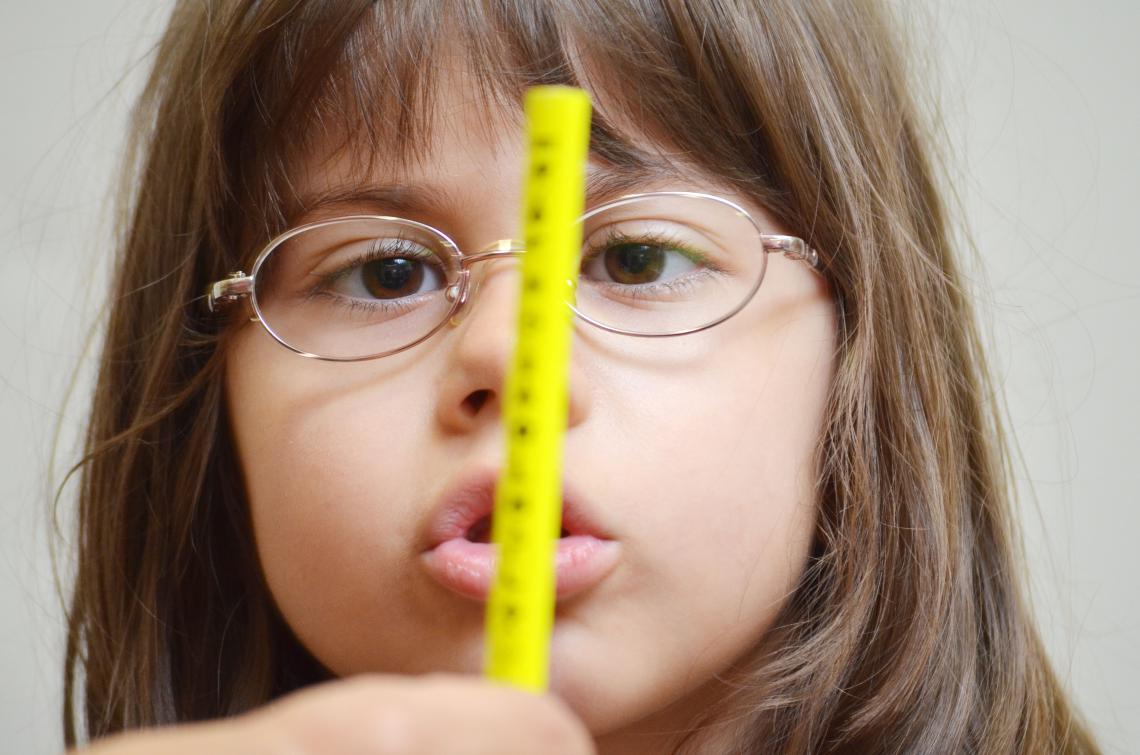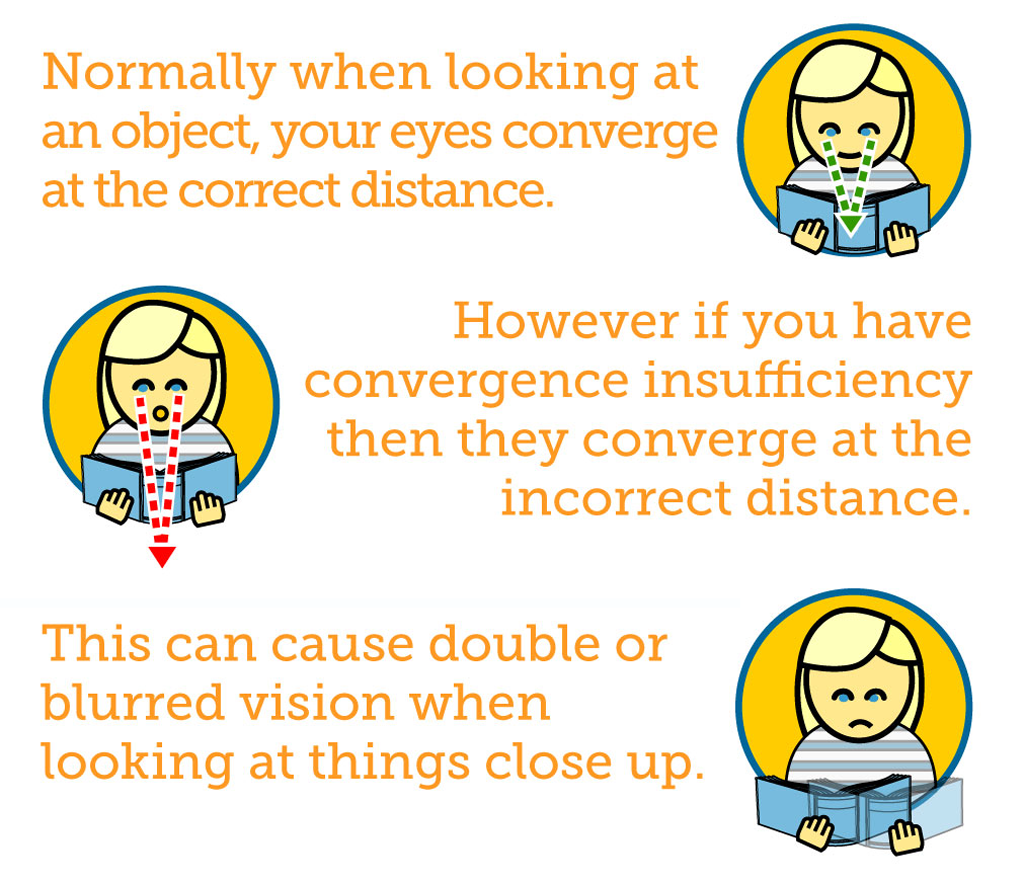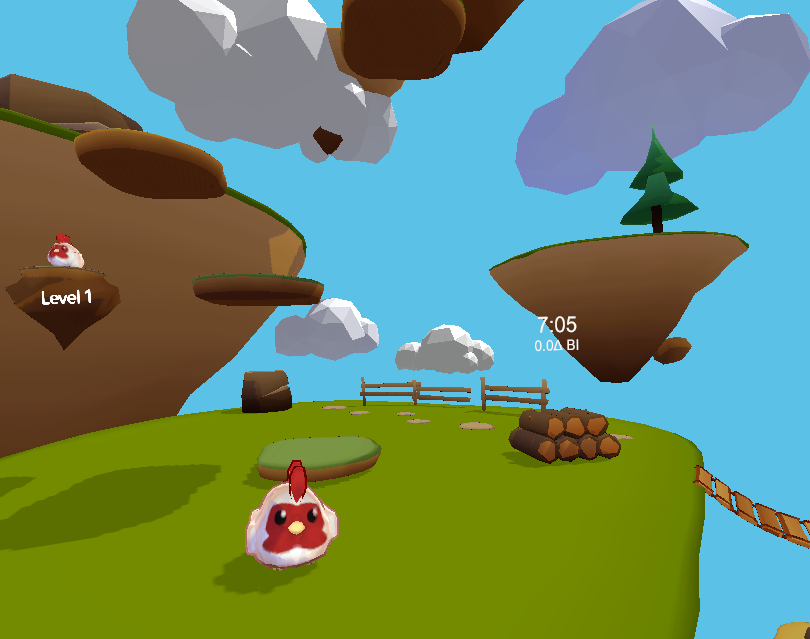What is Convergence Insufficiency?

Convergence is the coordinated movement and focus of our two eyes inward on close objects, including phones, tablets, computers, and books. Convergence is one of many vital visual skills learned during our early years, as we begin to make sense of the world and how to use our eyes to take it all in. Think of how much convergence a person must do throughout each day!
Convergence Insufficiency is a common problem with the development of these skills. When convergence is insufficient, it means that the eyes do not come together closely enough when looking at a near object, so the eyes are essentially looking "past" the target focal point.

Convergence Insufficiency affects approximately 5% of children in the United States, and may have a serious impact on an individual's performance in school, choice of jobs, and quality of life.
Symptoms of Convergence Insufficiency
When we are not able to converge our eyes easily and accurately, problems may develop, such as:
- Eye strain (especially with or after reading)
- Headaches
- Blurred vision
- Diplopia (double vision)
- Difficulty reading and concentrating
- Short attention span
- Frequenting losing their place while reading
- Avoidance of near work
- Poor sports performance
- Dizziness or motion sickness
- Trouble remembering what was read
- Words appear to move, jump, swim or float
- Squinting, rubbing, closing or covering an eye
It is not unusual for a person with convergence insufficiency to cover or close one eye while reading to relieve the blurring or double vision. Symptoms will be worsened by illness, lack of sleep, anxiety, and/or prolonged close work.
Many people who would test as having convergence insufficiency [if tested] may not complain of double vision or the other symptoms listed above because vision in one eye has shut down. In other words, even though both eyes are open and are healthy and capable of sight, the person's brain ignores one eye to avoid double vision. This is a neurologically active process called suppression.
Convergence Insufficiency disorder has often gone undetected because testing is not included in pediatrician's eye tests, school screenings, basic eye exams. A person can pass the 20/20 eye chart test and still have convergence insufficiency.
If untreated, in some cases, convergence insufficiency can lead to an outward eye turn that comes and goes. This is called intermittent exotropia.
Treatment of Convergence Insufficiency
Eye coordination problems like convergence insufficiency generally cannot be improved with eye glasses or surgery. A program of vision therapy may be needed to improve eye coordination abilities, reduce symptoms, and alleviate discomfort when doing close work.
The American Optometric Association and the 2008 Convergence Insufficiency Treatment Trial clearly support the superiority of office-based vision therapy, supplemented by at-home vision therapy, for treatment of convergence insufficiency.
"There are no visible signs of this condition; it can only be detected and diagnosed during a comprehensive eye examination," said principal CITT Study investigator Mitchell Scheiman, O.D., FCOVD, of Pennsylvania College of Optometry at Salus University near Philadelphia, PA. "However, as this study shows, once diagnosed, CI can be successfully treated with office-based vision therapy by a trained therapist along with at-home reinforcement."
How long is treatment for Convergence Insufficiency?
In general, 12-24 in-office vision therapy sessions are recommended to treat convergence insufficiency. This will vary based on compliance, the degree of convergence insufficiency (and other binocular disorders if present), age, and if there are any coexisting developmental disorders. With respect to regression following vision therapy, the Convergence Insufficiency Treatment Trial Group has found that 87.5% of children aged 9-13 were still considered either improved or successful one year after receiving treatment. Regression after vision therapy can occur after severe infection and/or traumatic brain injury.
Treatment for Adults with Convergence Insufficiency
The Convergence Insufficiency Treatment Trial found that for adults aged 19-30, 50% receiving office-based vision therapy for CI were either “improved” or “cured” after 12 weeks based on symptoms and clinical measures. It is possible that with more sessions there would have been a larger number of adults with CI benefiting from vision therapy. Also, investigators noted that the adults in this study improved the same amount clinically as children in another study suggesting that adults rate their symptomology differently than children.
In recent years, several randomized clinical trials have been published comparing the effectiveness of treatments for CI in children and adults. These studies have used both symptoms and clinical signs as outcome measurements. The results of these studies demonstrate that office-based vision therapy with home reinforcement is the most effective treatment for CI in children and adults. (4,5,6)
Vivid Vision and Convergence Insufficiency
In addition to games and activities for use in treating strabismus and amblyopia, Vivid Vision now features Barnyard Bounce. Barnyard Bounce is an interactive vergence game that allows patients to work on vergence facility while enjoying the fun and immersive quality of VR.
With the VR headset on, patients experience a virtual barnyard setting and see the main character of Barnyard Bounce, a chicken, ready to play. Patients navigate this adorable chicken character upward as it jumps to floating platforms that rise high above the barnyard floor. As the patient successfully moves the chicken upward using the controller, the vergence demand increases and decreases automatically. Providers can choose to work Base In or Base Out and the patient does the rest!
Patients that reach levels where the vergence demand is too much for them to handle will lose fusion and see two chicken characters. This makes it hard to perform the task successfully. As with all of our games, providers can adjust settings which allows them to work the patient’s ranges accordingly.
During the game, providers have an opportunity to check fixation disparity. Every couple of levels, the chicken appears to the dominant eye, a golden egg appears to the non-dominant eye, and binocular leaves fill the patient's field of view to encourage proper fixation. The patient needs to align the chicken with the golden egg several times to continue. Patients who are suppressing an eye or otherwise unable to fixate properly with both eyes may struggle with this portion of the activity.
See an Eye Doctor for Convergence Insufficiency
If you or your child has symptoms of convergence insufficiency or problems reading, consult an eye doctor for a comprehensive vision examination.
More Reading about Convergence Insufficiency
You may also be interested in these blog posts:
- Vision Therapy Success Stories: Amanda
- Who can benefit from using Vivid Vision Home?
- Do you have trouble reading? It might be a vision problem!
- Strabismus vs Amblyopia vs Convergence Insufficiency
- Signs You or Your Child May Benefit from Vision Therapy
